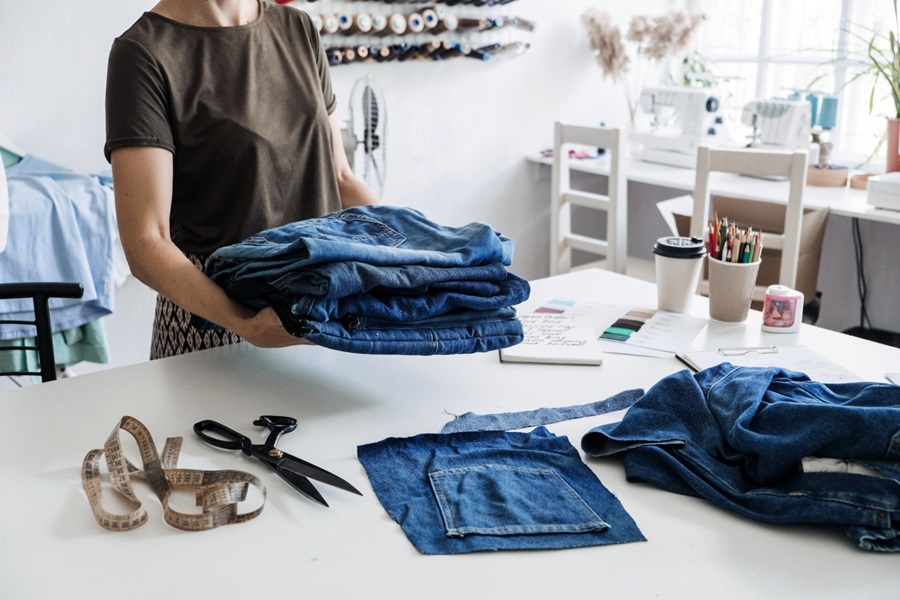Fashion is an unspoken language. It influences our view of someone before we have even met them. Clothes are a marker of a person’s individuality and identity. By its very nature, clothing is deeply personal. But we have moved away from clothes that last, both physically and emotionally, in favor of cheap, poor-quality clothing that gives us a quick fix of the latest trend. Unfortunately, there has been a shift in behavior where people buy and disregard without a second thought.
First, let’s assess the scale of global fashion consumption. Data gathered by The Round Up suggests 100 billion garments are produced every year by the fashion industry. According to sustainable fashion tech company, Common Objective, it is predicted that someone from the US is likely to purchase one item per week, although this varies heavily by country.
Changing attitudes and behaviors to fashion
Either way, there is no questioning the impact and ‘pull’ of the industry; the compulsion to buy clothing is reinforced day in, day out. There has been plenty of research to show the rewarding nature of buying clothes, but this impulse means people often end up with more than they need. According to the Fashion Retail Academy, 83% of people aged 18-35 said they have brought items that they have never worn and UK-based recycling and waste management company, First Mile found that 1 in 6 adults will throw away unwanted clothes, rather than seeking other sustainable alternatives. 61% say they have no interest in long-lasting clothes and 25% say they prioritize clothes that will only last a season. Kantar's latest Sustainable Sector Index report also shows how overconsumption and waste is the top concern for the fashion industry. It’s clear that we have developed unhealthy and unsustainable behaviors and attitudes to clothing and Fast Fashion brands have capitalized on this.
However, latest Kantar data shows a shift towards more sustainability-oriented behaviors, with 72% of respondents saying they only buy clothes when necessary and 46% saying they avoid fast fashion brands. People are embracing more circular behaviors too. 47% of respondents says they try to mend/repair items, up 5% from the previous year and more people are selling and buying second-hand, up 10.7% and 10.6% respectively.
Transitioning from a linear to circular economy
At its very best, fashion is diverse, creative, bold, and cutting edge. It’s an industry with all the characteristics and potential to lead the way, but it’s currently reliant on an inequitable, unsustainable linear economy; ‘take, make, waste’. The real potential for the industry lies in the circular economy; ‘eliminate, circulate, regenerate’. For fashion to become circular, we need a shift in mindset. We need to redefine the value in clothing, where value is beyond just the price of the product.
The Ellen MacArthur Foundation defines one of the key characteristics of a circular fashion industry as ‘producing and providing access to high quality, affordable and individualized clothing’. To date the market has been focused on producing clothes with more sustainable materials and innovative methods; however, as these innovations are not yet widespread, they increase the cost of the product. Access to sustainable products comes in the form of new business models, like clothes rental services and second-hand platforms, which allow for ‘greater flexibility and access to clothes that may not be affordable through traditional sales’. The value for these business models is in the use of the item, rather than the one-time sale price.
This definition of value offers new opportunities for fashion businesses to thrive within our planetary boundaries and give back to communities. Ultimately, these business models ‘democratize fashion’ by changing our preconceptions of ownership and consumption. And unlike fast fashion brands, they are sustainable as well as accessible and inclusive by design.
The sustainable value in circular fashion
Circular fashion businesses aren’t solely focused on selling; they also need to market the use, maintenance, and repair of products. This allows for far more touchpoints after purchase to reconnect than the traditional marketing-to-purchase funnel. These touchpoints are more authentic and less transactional and offer an opportunity to drive brand equity. Kantar's latest BrandZ research shows that brands with higher brand power, which are reflected in their relationships with their people, are worth 2.5 times more than brands with lower brand power.
People are used to provenance in food and drink, perhaps less so in clothes but this can connect us back to the natural world, the source of everything we have. Circular fashion businesses can be a conduit to nature, according to BrandZ data. When people see an item on clothing, they rarely think of the cotton field, farmers, and manufacturers further down the supply chain, or how the item eventually returns to the earth when disposed of. But there are brands attempting to reconnect people with nature. For example, using new technology like blockchain to improve traceability or regenerative programs that connect people with products origin story and the natural world. As an emotionally driven category, Fashion can be a strong storyteller, engager, and connector. Circular fashion businesses highlight the best of the industry and do this by design.
Finally, creating more meaning and connection to clothing could be the antidote to throw-away culture. By prioritizing the long-term we can bring more meaning back to fashion and create clothing that people will care for and cherish for longer. And ultimately, reduce waste. When we redefine value in the industry as more than just the number on swing tag, circular fashion has many more benefits; it’s inclusive, sustainable, and engaging.
To learn more about how your brand can adapt and benefit from circularity get in contact with our sustainability experts and read more on how brands can build stronger connections with customers in the Kantar BrandZ Most Valuable Global Brands report.


